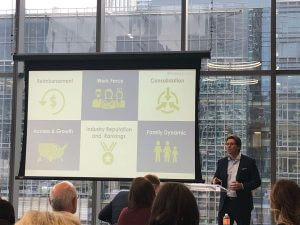
AVIA’s Guide to Scaling Healthcare Innovation
AVIA
Insights
Marc Griffin, Vice President, Children’s Hospitals Strategic Initiative, AVIA

Last month, 15 children’s hospitals, including Children’s Hospital Colorado, Children’s Wisconsin, Arkansas Children’s Hospital, UVA Children’s, and Boston Children’s Hospital, came together with AVIA to begin the journey to improve the lives of children, caregivers, and parents through the deployment of digital solutions, with an initial focus on pediatric remote monitoring.
Children’s hospitals are unique in that they have always worked closely together, historically collaborating to improve clinical quality. However, they are experiencing a paradigm shift: Millennials are parents to over 50% of today’s children. To both compete with new entrants disrupting traditional healthcare delivery and also provide care differentiated on quality, outcomes, cost, and convenience that today’s tech-savvy Millennial parents expect, leading children’s hospitals have also recognized the need to collaborate in the area of digital innovation.

These hospitals understand that traditional assets are no longer enough: they see digital solutions as a new asset class to help them grow their catchment areas, retain patients, drive margins, and, ultimately and most importantly, improve clinical care. AVIA is working with children’s hospitals to prioritize digital opportunities, build the case for action, and enable faster decision making with greater confidence, all while providing the tools and expertise to measure the quantifiable impact of digital on their organizations.
Our Children’s Hospital Members are in the process of setting the agenda for 2020 — join us today to help us determine two additional areas of exploration where digital innovation can have an outsized impact on pediatric care. To learn more about AVIA’s Children’s Hospital Membership, contact us at childrens@avia.health.
At our premier event for the Children’s Hospital Initiative last month, the children’s hospitals in attendance represented over 25% of all patient revenue at children’s hospitals in the US, and the room was charged with a palpable excitement over the opportunity of this collective to drive innovation forward.
Claudia Hoyen, MD, UH Rainbow Babies and Children’s Hospital, described the power of the hospitals gathered together: “We are going to be faster, stronger, better if we work together on the same projects.”
The event was focused on pediatric remote monitoring’s capabilities to improve clinical care, expand the reach of providers, free up capacity for higher-acuity patients, and reduce children’s hospitals’ costs. Several leading children’s hospitals in attendance shared their experiences building out pediatric remote monitoring programs. Read on for highlights.
The neonatal intensive care unit (NICU) at UVA Children’s was at 120% bed capacity, meaning UVA was forced to turn babies away or build more beds. Meanwhile Brooke D. Vergales, MD, neonatologist and program director for the Neonatal Fellowship at UVA, held a strong conviction that, whenever possible, babies do better at home.
As a result, Dr. Vervales championed, developed, and, for its first year, independently operated their NICU’s first-ever remote monitoring program. Remote monitoring data was automatically added to the EMR, giving providers a real-time view into these babies’ health, eliminating the need for parents to interpret and record data, and minimizing nurses’ time spent collecting it.
In the past 1.5 years, the platform has enabled UVA to safely send home 45 children who would have otherwise remained in the NICU, opening up limited capacity. UVA has seen a positive ROI and alignment with its mission from remote monitoring, due to its ability to turn away fewer children needing care.
Dr. Vergales emphasized the importance of scaling the program across the organization to maximize ROI. “The investment is too large to launch a program for just one patient population.” Besides the NICU, a remote monitoring program is in place in cardiology, and UVA is planning to launch remote monitoring for cystic fibrosis and organ transplant patients.
UH Rainbow Babies and Children’s Hospital, Cleveland, OH, is part of an accountable care organization (ACO) operating under a bundled payment model. They have a remote monitoring program for their pediatric patients with cardiology diagnoses.
Since Rainbow Babies operates under bundled payment, their remote monitoring program is paying for itself in hospital savings. In fact, Dr. Hoyen stated that for every one potentially preventable admission that is avoided, the costs saved pay for 30 children per year to be monitored.
Besides the clear ROI of their program, other success factors at Rainbow Babies have included:
Finally, Robin Deterding, MD, Children’s Hospital Colorado, summed up one of the most important benefits of remote monitoring — its ability to get kids home to their families faster.
Dr. Deterding showed event attendees a picture of a patient’s door, decorated to celebrate the child’s birthday. “Birthdays in hospitals don’t make me smile, they break my heart. This kid has been in the hospital for years. This is no longer acceptable. We need technology that can help get kids home sooner.” She emphasized that the group gathered together had the power and responsibility to adopt the technological innovations and create a culture of urgency and change to improve care for these children and their loved ones.
Delivering pediatric care is rife with obstacles relating to family dynamics, reimbursement challenges, workforce shortages, and geographic complexities. Children’s hospitals must juggle these challenges, all while working to improve access and growth and keeping a keen eye on their reputation and rankings. AVIA is excited about the power of our multi-year journey to create a network of like-minded children’s hospitals who seek to unlock the power of digital to solve a myriad of pressing challenges.
To learn more about pediatric remote monitoring and AVIA’s Children’s Hospital Initiative, contact us at childrens@avia.health.

Children’s Hospital Resources
To learn more about AVIA’s Children’s Hospital Initiative, contact us at childrens@avia.health.